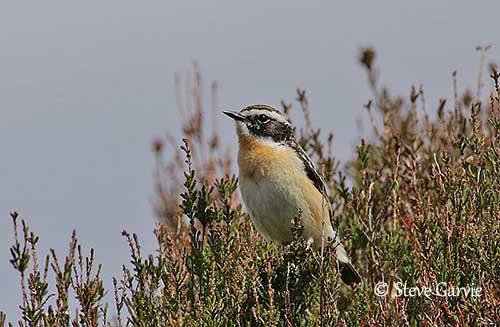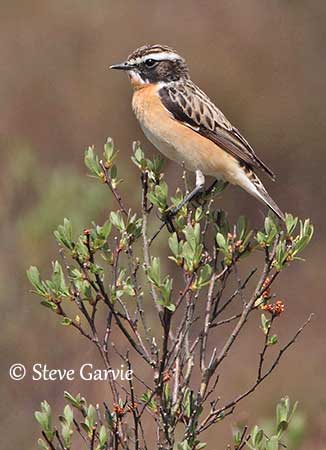
Fr: Tarier des prés
Ang: Whinchat
All: Braunkehlchen
Esp: Tarabilla Norteña
Ita: Stiaccino
Nd: Paapje
Sd: buskskvätta
Photographers:
John Anderson
John Anderson Photo Galleries
José Luis Beamonte
Pájaros de España
Didier Buysse
Vision d’Oiseaux
Steve Garvie
RAINBIRDER Photo galleries & Flickr Rainbirder
Otto Plantema
Trips around the world
Ingo Waschkies
Bird Photography
Text by Nicole Bouglouan
Sources:
HANDBOOK OF THE BIRDS OF THE WORLD Vol 10 by Josep del Hoyo-Andrew Elliott-David Christie - Lynx Edicions - ISBN: 8487334725
THE COMPLETE BOOK OF BRITISH BIRDS – Written by “Royal Society for the Protection of Birds” experts - Préface de Magnus Magnusson - Michael Cady- Rob Hume Editors - ISBN: 0749509112
THE HANDBOOK OF BIRD IDENTIFICATION FOR EUROPE AND THE WESTERN PALEARCTIC by Mark Beaman, Steve Madge - C. Helm - ISBN: 0713639601
ENCYCLOPEDIE DES OISEAUX DE FRANCE ET D’EUROPE – de Peter Hayman et Rob Hume - Flammarion – ISBN : 2082009920
BIRDS OF AFRICA SOUTH OF THE SAHARA by Ian Sinclair and Peter Ryan - Princeton University Press Princeton and Oxford - ISBN: 0691118159
BIRDS OF THE MIDDLE EAST by R.F. Porter, S. Christensen, P Schiermacker-Ansen C.Helm - ISBN: 0713670169
Wikipedia, the free encyclopaedia
What Bird-The ultimate Bird Guide (Mitchell Waite)
Pájaros de España (JL Beamonte)
Birdwatch – The Home of Birding
The Guardian - The whinchat in decline on lowland farms
The Breeding Biology of the Stonechat and Whinchat
Whinchat
Saxicola rubetra
Passeriformes Order – Muscicapidae Family
INTRODUCTION:
The Whinchat is easily confused with the European Stonechat (S. rubicola), but it presents a broad, pale supercilium in all plumages, making it very distinctive. It also has rounder head and shorter tail. It is now a member of the family Muscicapidae.
This species is migratory and breeds in Europe and W Asia. It spends the winter in tropical sub-Saharan Africa. It breeds in open country, heathland, wet meadows and upland pastures. During winter, it is found in moist open areas with low perches, grassy marshes, forest edges and clearings. It is often solitary, but it forms small family groups after the breeding season.
The Whinchat is not globally threatened, but the population trend is decreasing, probably due to agricultural intensification.

DESCRIPTION OF THE BIRD:
Biometrics:
Length: 12-14 cm
Wingspan: 22-23 cm
Weight: 13-26 g
The Whinchat male in breeding plumage has conspicuous blackish sides of head with prominent white supercilium. The blackish crown is streaked buff. There is a narrow white line extending from chin to neck sides.
On the upperparts, mantle to rump is buff, streaked and spotted with blackish. The upperwing is blackish with buff-edged feathers and white alula. The short tail is black with white bases to outer rectrices.
On the underparts, throat and breast are orange to rufous-ochre, becoming white on belly and undertail-coverts.
Bill, legs and feet are black. The eyes are dark brown.
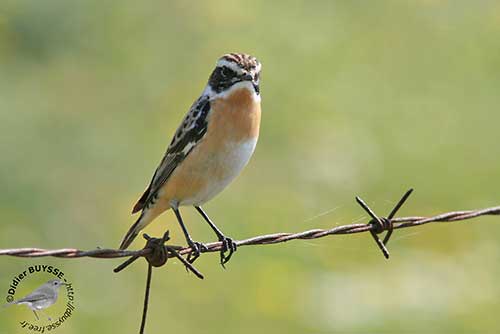
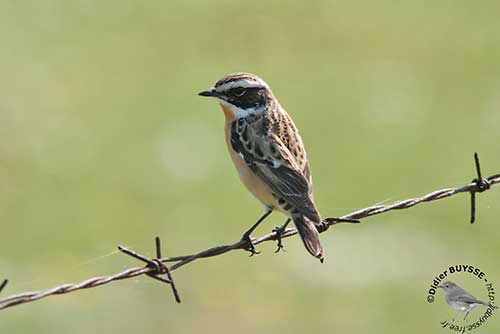
The non-breeding male has buffer head and shows dark stippling on breast.
The female resembles male but with less distinct pattern. She has brown face and buffy supercilium, and less white on wings and tail.
The juvenile is similar to female but is shows dark mottling and scaling on breast and flanks.
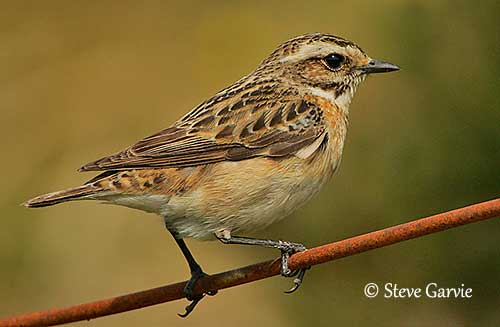
RANGE:
The Whinchat breeds in Europe, E to W Siberia, NW and E Asia Minor, Caucasus and NW Iran. It winters in tropical sub-Saharan Africa from Senegal E to Kenya, and S to Zambia. Small numbers also winter in NW Africa.
This species is vagrant to Iceland, Canary Islands and Cape Verde, and N South Africa.
HABITAT:
The Whinchat breeds in a wide variety of habitats including wet meadows with abundance of insects, heathland, upland grassland and pastures, hillsides with ferns, fringes of reedbeds, open areas with scattered bushes, shrubs and trees used as perches, and bare ground or low herb cover for foraging.
During winter, it frequents open grassland with patches of stunted scrub with low perches, forest edges and clearings, harvested fields, degraded savanna and bare hilltops. It can be seen up to 2300 metres of elevation in Uganda.
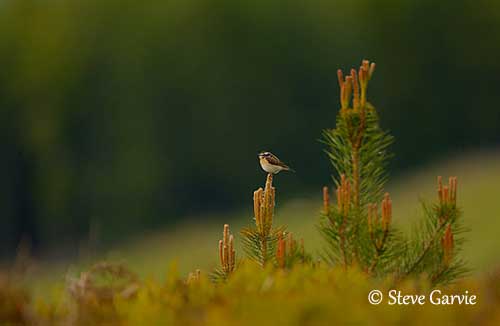
CALLS AND SONGS: SOUNDS BY XENO-CANTO
The Whinchat often gives a scolding “tek-tek” or “whu-tek-tek” used both as contact and alarm calls.
The song is short and fast, an abrupt warbling series of variable phrases, including melodious and scratchy notes, and some mimicry. It often sings at night.
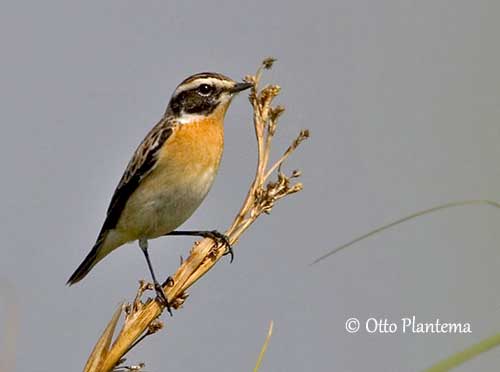
BEHAVIOUR IN THE WILD:
The Whinchat feeds primarily on invertebrates including insects adult and larvae of numerous species such as coleopteran, lepidopteran, dipteran, ants and bees, dragonflies and grasshoppers. It also takes spiders, snails and earthworms, and several other invertebrate species.
It often hunts from perch and swoops down on to the prey on the ground. It forages less frequently in vegetation or in flight, but during winter, when the tall vegetation hides the open areas, it may perform sallies to catch a prey. It feeds on fruits and seeds in autumn.
It usually perches with less upright posture than the European Stonechat, with less flicking wings and tail, except when threatened.
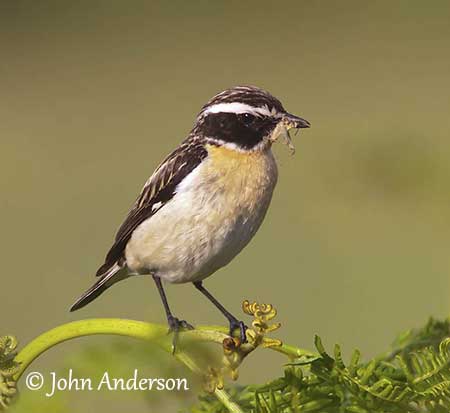
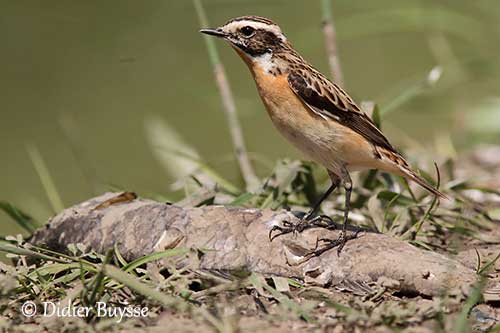
Photographer's comment:
The male is on a dead fish. In my opinion, it’s the best position to catch the insects attracted to the carcass...
The Whinchat is usually monogamous, with sometimes changes of mates during the season. The male arrives first at the breeding sites and establishes the territory. It sings loudly and performs elaborate displays. It sings from a perch with drooping wings, fanned tail and raised head in front of the female. This species shows high site-fidelity and returns to the same area every year.
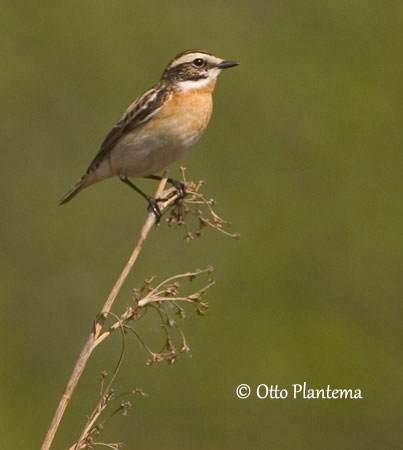
The Whinchat is migratory and leaves the breeding grounds in late August to September. Ringing recoveries from N Africa in autumn suggest that numerous birds make a single flight across Sahara from S Europe. The main arrivals on the wintering grounds occur in October/November, but late October to December in the southernmost areas.
The return migration starts in February in Zambia, and mid-March to early April in W Africa. The main spring passage in Middle East occurs between April and early May. They arrive at their breeding grounds in mid-April in south, but the northernmost parts of the breeding range are occupied only from late May.
The Whinchat has strong, fast flight with several rapid wingbeats interspersed with short glides.

REPRODUCTION OF THIS SPECIES:
The breeding season takes place from mid-April to early August. The Whinchat’s nest is placed on the ground, in low bush or tussock. It is a cup-shaped structure made with grass stems, leaves and moss, and lined with finer material and hairs.
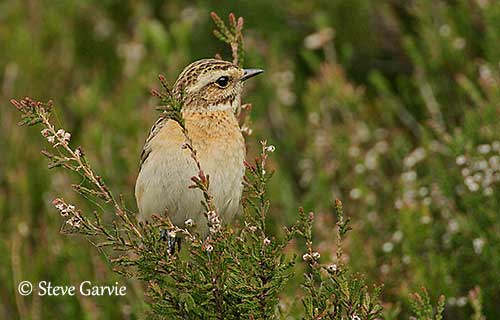
The female lays 2-7 pale blue-green eggs with fine reddish-brown markings. She incubates alone during 12-15 days. The young are fed by both parents and fledge 13-14 days after hatching. They are able to fly at 17-19 days. They still depend on parents for 15-18 days after fledging. This species may produce 1-2 broods per season.
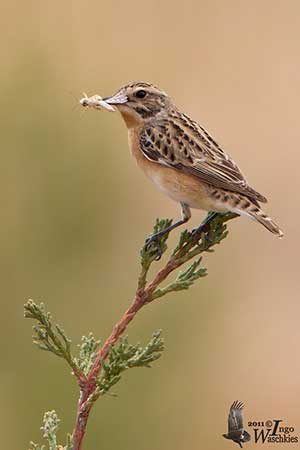
PROTECTION / THREATS / STATUS:
The Whinchat is fairly common throughout its wide range. However, some declines are reported in the west of the range, mainly due to agricultural intensification.
The global population is estimated at 17,200,000/28,500,000 individuals, but further validation of this estimate is needed.
The Whinchat is currently evaluated as Least Concern.
